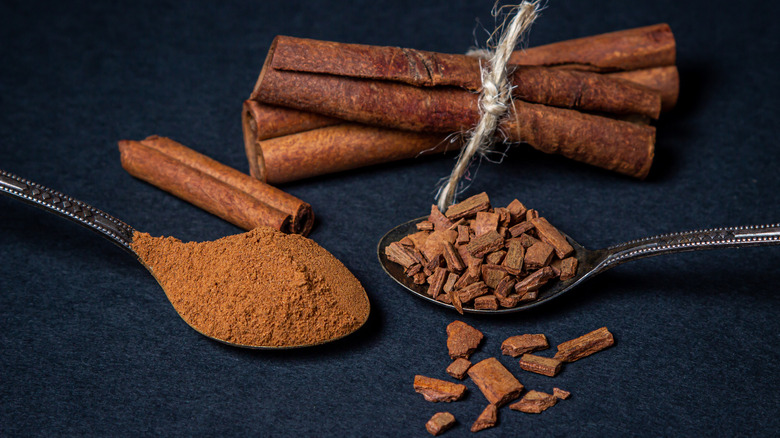Cinnamon is made from the brownish-reddish inner bark of cinnamon trees. All varieties of cinnamon are members of the Lauraceae plant family, which has been used historically as a spice and a general remedy.
After the age of six months, cinnamon is typically regarded as safe to give to kids in small amounts. Cinnamon seldom causes an allergic reaction in either children or adults. Due to cinnamon’s ability to prevent blood clotting, it may result in bleeding issues, stomach discomfort, skin irritation, and mouth irritation. However, adding some cinnamon to your baby’s diet won’t do any harm. If your child becomes anxious and restless after eating cinnamon or appears to be allergic to cinnamon-containing foods, contact your doctor immediately.
Where Can You Find Cinnamon?
Cinnamon is a common spice that is used to flavor a variety of foods and other items. Spices like cinnamon can be found in a wide variety of dishes. It might be a part of the following:
- gummy bears
- toothpaste
- Oatmeal, applesauce, and cereal for breakfast
- sweets that have been baked, such as cookies, muffins, pies, cakes, biscuits, and pastries
- Candies
- mouthwash
- flavor-infused beverages
- French toast
Cinnamon is a common spice to keep on hand. Cinnamon can also be found in spice blends like garam masala or pumpkin pie spice, for example. Reviewing the list of ingredients on a product’s label is the only way to know for sure if it includes cinnamon.
According to studies on the benefits of cinnamon, a small amount of the spice (about a half teaspoon for humans) may be good for your health. The positives might include:
- decreasing LDL cholesterol, total cholesterol, and triglycerides
- reducing blood pressure and controlling blood sugar
- the fight against Candida fungus infections
- reducing nauseousness
- keeping blood clots from forming accidentally
The Perilousness of Cinnamon
Cinnamon allergies are relatively uncommon. However, children who consume excessive amounts of cinnamon run the risk of experiencing gastrointestinal problems, skin rashes, and, in rare cases, an allergic reaction. Given that, it’s generally not a good idea to give your baby too much of anything.
A tiny percentage of people are intolerant to cinnamon, just like they are to other foods. If you or members of your family have hay fever, asthma, eczema, or other allergies, there is a higher chance that your baby will as well.
How Will I Be Able To Tell If My Child Is Allergic?
If your infant has a cinnamon allergy, their immune system will battle it since it doesn’t see it as acceptable. Antibodies are produced by the immune system, along with histamine. The histamine causes inflammation and irritation all across the body.
The symptoms of a cinnamon allergy might differ significantly from person to person. Skin, digestion, respiratory, and cardiovascular systems can all be negatively impacted by food intolerance. Symptoms of food allergies typically appear between an hour and a day after consuming the offending food.
Skin Conditions
An allergic skin response might manifest itself in several ways. Minutes after skin contact with the allergen, a reaction called contact dermatitis causes a rash to appear. Skin reactions could also occur following the ingestion of an allergen. The following skin conditions may result from an allergic reaction:
- an itchy rash,
- Eczema or blisters
- Skin irritation or aggravation
- mouth redness accompanied by stinging or itching
- gastrointestinal symptoms
Additionally, a food allergy may result in the following signs or symptoms:
- abdominal pain
- both nausea and diarrhea
- a cold-like condition
Other widespread warning signs and symptoms of food allergies include:
- wheezing, coughing, and breathlessness
- a blocked or runny nose,
- tongue, and throat (congestion of the nasal passages)
- Irritation and rosy eyes
Anaphylaxis
Rarely, a hypersensitivity reaction might cause serious symptoms known as anaphylaxis. There may be a risk to life because of a medical emergency. If you require immediate medical attention, dial 911.
Anaphylaxis symptoms include the following:
- breathing is made more difficult by a swollen throat and lips.
- a narrowing of the airways that causes dizziness, coughing, or wheezing
- lightheadedness
- Vomiting and shivering
- an unexpected drop in blood pressure
- awareness is lost
- rapid breathing
What Foods Are Known to Frequently Cause Allergic Reactions?
Cinnamon is not typically included on the list of food allergies that affect infants and young children. It’s unlikely that adding a little cinnamon to your baby’s oatmeal or baby food would have any negative effects.
Children are more likely to experience allergic reactions to specific meals. According to Food Allergy Research and Education, these eight foods are responsible for 90% of all food allergies:
- Milk
- eggs
- peanuts
- fish, shellfish,
- tree nuts
- Soy
- wheat
Your baby should not consume any of these meals before the age of six months. When you first begin giving your baby particular foods, be careful to keep an eye out for signs of an allergic reaction. If you notice any symptoms, be sure to let someone know.
How Should I Proceed If I Think My Baby Is Reacting Allergically to Cinnamon?
In order to determine whether cinnamon is to blame for the reaction, a doctor might suggest conducting a skin patch test on your infant. For 20 to 30 minutes, a doctor will apply a small patch of cinnamon to your child’s skin. Your baby probably isn’t allergic to cinnamon if the skin looks normal after the patch is removed. To check for a cinnamon allergy, your doctor might also request a blood sample.
If the baby turns out to be allergic to cinnamon, your doctor will advise staying away from it and removing it from their diet. It’s important to carefully read all food labels, especially those for items that frequently include spices. A person with a food allergy should take extra care when eating out or purchasing food from a store to make sure there are no traces of the allergen left in the food. Ensure that cinnamon is not an ingredient in items like toothpaste or lotions.
It is impossible to prevent or treat food and spice allergies with medications. To handle any allergies your kid might have, you should consult with their doctor.
You can be sure that if your baby doesn’t have a cinnamon allergy, giving him or her very small amounts of cinnamon will be both risk-free and enjoyable for them.
Spice Up Your Baby Food with These Recipes
Using spices like cinnamon is a great way to give your baby’s food an interesting flavor without having to add any sugar or salt. Before experimenting with foods and spices, you should wait until your infant is at least 6 months old.
To spice up the flavor of the following common infant meals, add cinnamon:
- apple yogurt sauce
- bananas
- pumpkin
- candy potatoes
- Oatmeals
- Rice
- quinoa
Alternatively, you could make your baby food and flavor it with cinnamon. For a tasty sweet and savory dish, follow this recipe for roasted pumpkin and sweet potato baby food. For a tasty baby treat, check out this recipe for baby food that includes apricots, bananas, and cinnamon.
Resources:
- Cinnamon, ground. (n.d.)
whfoods.com/genpage.php?tname=foodspice&dbid=68 - Dugoua, J., Seely, D., Perri, D., Cooley, K., Forelli, T., Mills, E., & Koren. G. (2007). From type 2 diabetes to antioxidant activity: a systematic review of the safety and efficacy of common and cassia cinnamon bark. Canadian Journal of Physiology and Pharmacology, 85, 837-847, 10.1139/Y07-080
nrcresearchpress.com/doi/abs/10.1139/Y07-080#.VmnmKbgrLIX - Facts and statistics. (n.d.)
foodallergy.org/facts-and-stats












